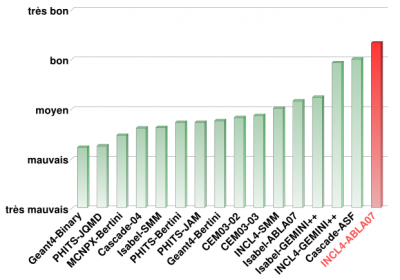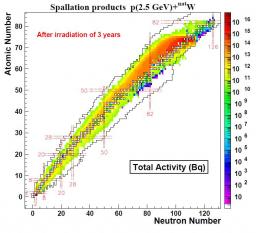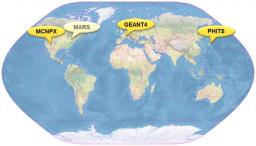For many years, the SPhN Spallation group has been developing, in close collaboration with the University of Liège, a model describing spallation reactions, called INCL. Based on its remarkable performance in an international evaluation, this model has just been included in three of the major simulation codes used worldwide to model and design the facilities in which these reactions occur.
Spallation reactions
Among the different types of nuclear reactions, there are so-called spallation reactions. They occur in space when cosmic radiation nuclei interact with interstellar gas particles or meet satellites. They also occur in targets bombarded by particles from accelerators designed to produce intense neutron fluxes, generate rare isotopes or feed subcritical reactors for the transmutation of nuclear waste. More precisely, spallation reactions involve a nucleus and a particle, usually a nucleon (proton or neutron), with an energy between 100 and a few thousand MeV1. At these energies, the incident nucleon sees the nucleus as a set of nucleons with which it will make a series of collisions and eject some of the struck nucleons. This first step, which is fast, is called an intranuclear cascade. It leaves a nucleus smaller than the target nucleus and in an excited state. The latter then slowly de-excites by emitting low-energy particles or, sometimes, by splitting into several pieces. The final nuclei are called residual nuclei.

Result of the evaluation of the spallation models: average assessment obtained by the different models with regard to the prediction of the production rates of residual nuclei as a function of their mass or charge.
The Modeling
For many years, the SPhN Spallation group has been developing, in close collaboration with the University of Liège, an intranuclear cascade model, called INCL42. This, coupled with a de-excitation model, describes the mechanism of the spallation reaction and predicts the nature and characteristics (energy, emission angle) of the different nuclei and particles produced during the reaction.
In 2010, the IAEA organized a comparison of the different spallation models used worldwide with a representative set of experimental data, covering a wide range of responses and observables. This evaluation showed that the INCL4 model, coupled with the ABLA07 de-excitation model developed at GSI Darmstadt, gives the best overall agreement with the data, especially when it comes to predicting the characteristics of residual nuclei or emitted composite particles [1].
Since then, the model has been further improved and extended to reactions below 100 MeV and induced by composite particles. This is the subject of an article recently accepted for publication in Physical Review C [2]. In parallel, the code has been completely rewritten in C++, a language that is now widely used... This version also contains an extension to reactions induced by light ions (up to oxygen) for medical applications.
1MeV = Mega electron Volt
2INCL = Intra-Nuclear Cascade from Liège
Transport codes
When simulating a system such as a spallation source, a subcritical reactor or a spacecraft, it is necessary to use what is called a transport code in which all particle-matter interaction processes (nuclear and electromagnetic) are taken into account and all particles are being monitored. The transport code uses a model for spallation reactions that provides the interaction probabilities and characteristics of the secondary particles generated.
There are a small number of transport codes widely used around the world. The American MCNPX code and its Japanese equivalent PHITS are the most commonly used for applications related to spallation sources and subcritical reactors. FLUKA is a CERN-INFN code used mainly in radiation protection and medical applications. Finally, GEANT4 (from an international collaboration focused on CERN) and MARS (from Fermilab in the USA) were originally developed mainly for the simulation of detectors in subatomic physics but are now used for multiple applications.
In many of these transport codes, the models describing spallation reactions are relatively old and were not very predictive in the IAEA assessment. In view of INCL4's performance, PHITS developers not only wanted to integrate the model into their code but also to make it the default model. A cooperation agreement was signed last February with the JAEA3 on this subject. INCL4 has also been included in a version of MCNPX and should soon be included in MCNP6, which is to succeed it. Finally, the C++ version with its extension to light ions can be used in the latest GEANT4 distribution.

Activity (in Becquerel) of the different isotopes produced by the spallation reactions in the ESS tungsten target as a function of the charge and mass of these isotopes at the end of a 3-year irradiation period.
Examples of applications
It is now possible to use INCL4 to simulate various applications of spallation reactions. For example, calculations were made with MCNPX for the European Spallation Source (ESS) project in Sweden. The aim was to predict the radioactive nuclei produced by irradiation by the 2.5 GeV proton beam of the proposed tungsten target.
Another example is an experiment at the ISOLDE facility at CERN, where a proton beam bombarded a liquid lead-bismuth target. This experiment had revealed the production of astatine nuclei incorrectly predicted by previous calculations. These astatine isotopes are derived from very specific reaction pathways and are potentially hazardous.
Indeed, the astatine is volatile and its isotopes decrease towards polonium isotopes, particularly dangerous. The simulation with MCNPX showed that INCL4 reproduced the production of astatine isotopes, unlike the other models available in the code. This success is due in particular to the fact that INCL4 correctly predicts both the production of helium nuclei in primary reactions and the secondary reactions induced by these nuclei, which are responsible for most of the astatine production.
These results were accepted for publication in European Physics Journal A[3].
Prospects for the future
Based on its success, the model is now implemented in three of the most widely used transport codes in the world. The authors of the MARS code are also interested in the model but would like an extended version with higher energy (up to 15 to 20 GeV). This requires the inclusion of new channels for the production of strange particles, a task that the Spallation group will be working on in the coming years. In addition, the extension to nucleus-nucleus collisions, which is important for medical and space applications, will be continued.
Contact IRFU/SPhN: A. Boudard, J.C. David, S. Leray and D. Mancusi
[1] http://www-nds.iaea.org/spallations/
[2] A. Boudard et al., Phys. Rev. C 87 (2013) 014606
[3] J.C. David et al., Eur. Phys. J. A (2013)
3 Japan Atomic Energy Agency
• Structure of nuclear matter › Nuclear reaction dynamics Structure de la matière nucléaire
• The Nuclear Physics Division




